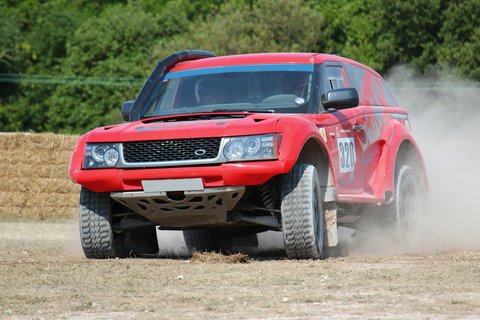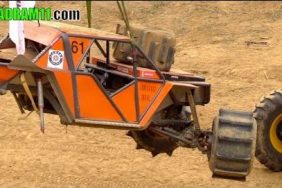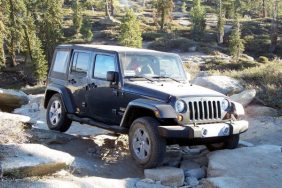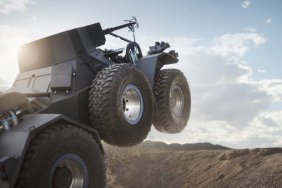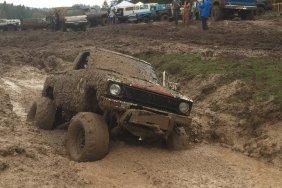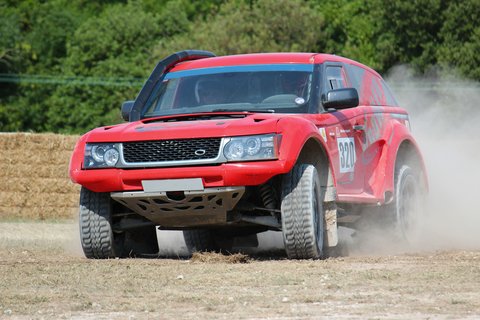
It’s not a truck. It’s not a jeep. It’s a rig. A common refrain you might here: “Hey man, why is there no mud on your rig?”
There’s a reason they are called rigs. Any weekend rube can go get himself an off-the-lot Exploder and go around trying to look special out in the dirt, but the hard-core off-roaders — the ones with 50 weight and lithium grease worked permanently into their fingers — can spot the rube from 1,000 yards. These guys drive rigs, because they’ve either customized them, modified them, torn apart and rebuilt them, or simply built them from scratch.
These are the hoofprints of a genuine and devout off-roading disciple.
In fact, as much time is spent in the activity of building and refining the rig as is bombing up and down the trails. And another benefit of having built it yourself is that you know how to handle any self-actualized emergencies. Much like a Soviet MiG pilot, reputed to be able to land his damaged plane in a farm field and wrench it back into the air with a compliment of tools, the ones who drive the rigs are the ones who can hack it.
If you have the time, the tools, and a friend or two with the proper head for mechanical remodeling, then you too can earn the title of “rig driver.” We’ve assembled some tips to help get you started:
Try a basic build
Start with a workable vehicle. Newer 4WDs like the Nissan Xterra have a smooth-riding independent front suspension. They can tackle easy trails with minimal modifications and still maintain on-pavement road manners. For the engine, Don’t void the warranty. Reusable air filters improve filtration and breathing. When combined with an exhaust system that installs behind the catalytic converter, these safe upgrades can yield up to 10 hp.Maintain stock height to preserve the factory handling and stability. Aftermarket off-road shocks can offer better control over rough terrain. The tradeoff? A firmer ride on the street. Keep in mind that large tires hurt fuel economy and off-the-line thrust. Instead, mount a stock-size mud tire. Choose a limited-slip differential for the rear axle to get better grip on pavement and off. Aluminum skidplates underneath help protect drivetrain components. A tow hook or clevis shackle bolted securely to the frame is essential for snatch-strap or winch recovery.
Move up to an intermediate build
Go this route for more robust rigs. Trucks with a live-axle front suspension, like 1973-1991 Chevy Suburbans or comparable K-Series pickups, make tough platforms. These vehicles can be bought and built inexpensively.
A factory crate motor is reliable and will improve power. Of course, powerful motors can break parts, So plan to upgrade the drivetrain if you add serious horsepower. A two to four inch suspension system and longer shocks create room for larger tires, increase axle articulation and boost capability. But systems with more lift typically ride rougher. When choosing tires, taller and wider 33- to 35-inch tires raise ground clearance over obstacles and improve flotation. Add a selectable locking differential in the rear axle for maximum traction at both rear wheels. A winch can extricate your truck from the worst-case-scenario stuck. Electric winches are expensive but worthy investments–especially when four-wheelers travel alone.
Extreme build
Now you’re ready for the big time. This is the kind of rig guys will stand around, spitting on the ground, and making general statements about the performance and fun afforded with a serious rig.
For vehicle choice, a classic two-door Jeep CJ or Wrangler is a perfect blank canvas to build a hardcore 4×4. Jeep parts are plentiful, and there’s a deep knowledge base for what works and what doesn’t. A V8 or diesel conversion delivers the torque to turn large tires. Upgrade to larger heavy-duty-truck-spec axles, transmissions and transfer cases, which are often needed to handle the stress. When choosing suspension, expensive coil-link systems can provide incredible suspension flex for serious rock crawling. They offer excellent ride quality on the road as well.
You’ll want tires at least 37 inches. Suspension articulation helps maintain traction, but the toughest trails require a locking differential. If the Jeep has no hardtop, consider a full roll cage to protect in case of rollover. A winch is standard in this class of vehicle.
